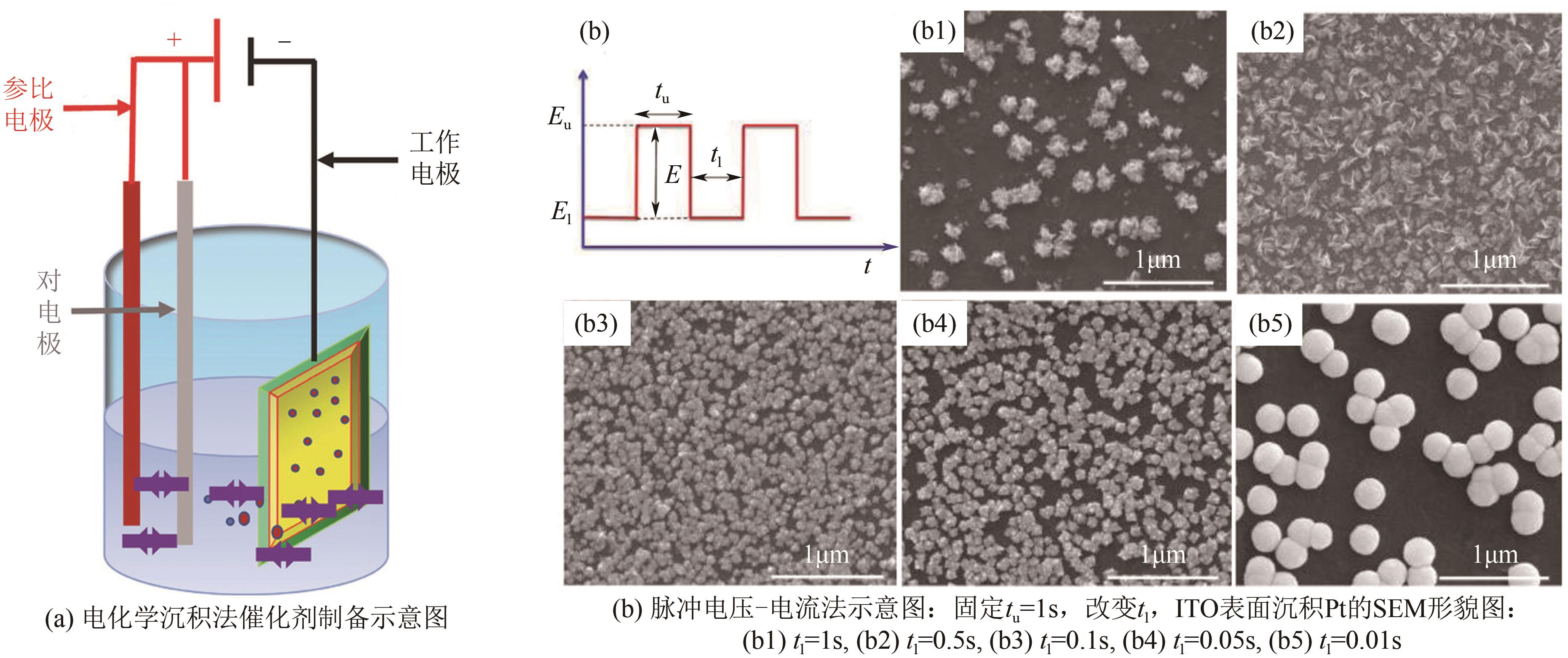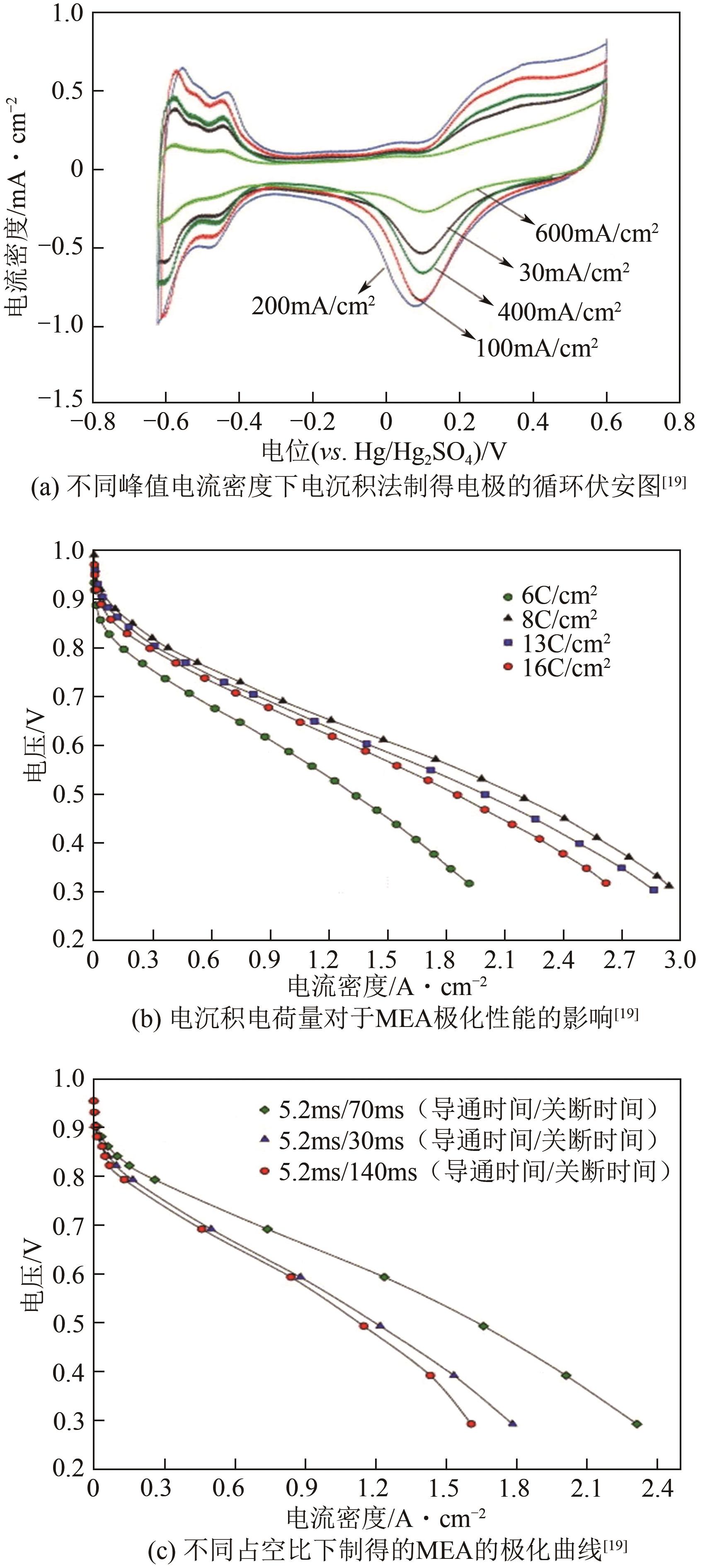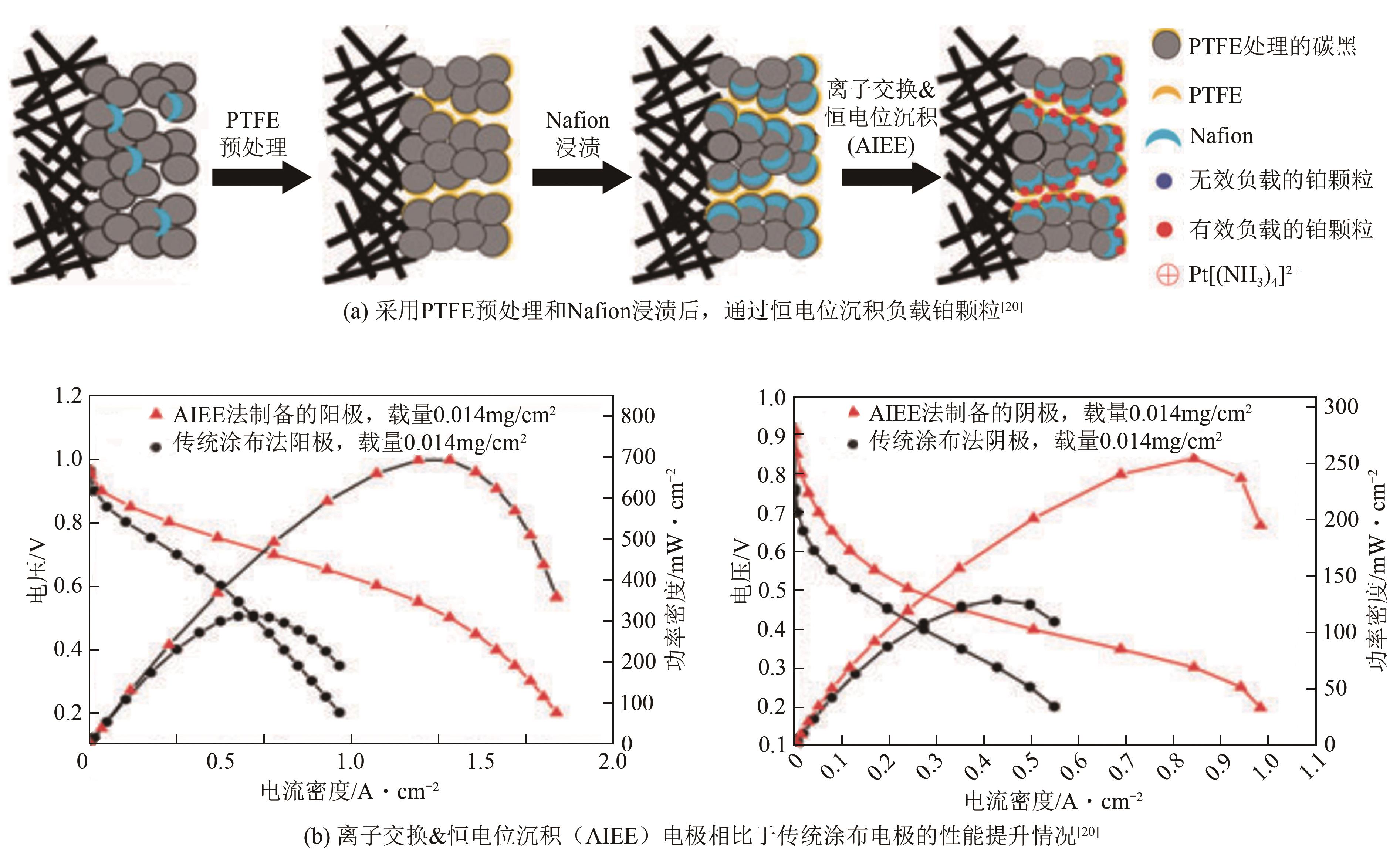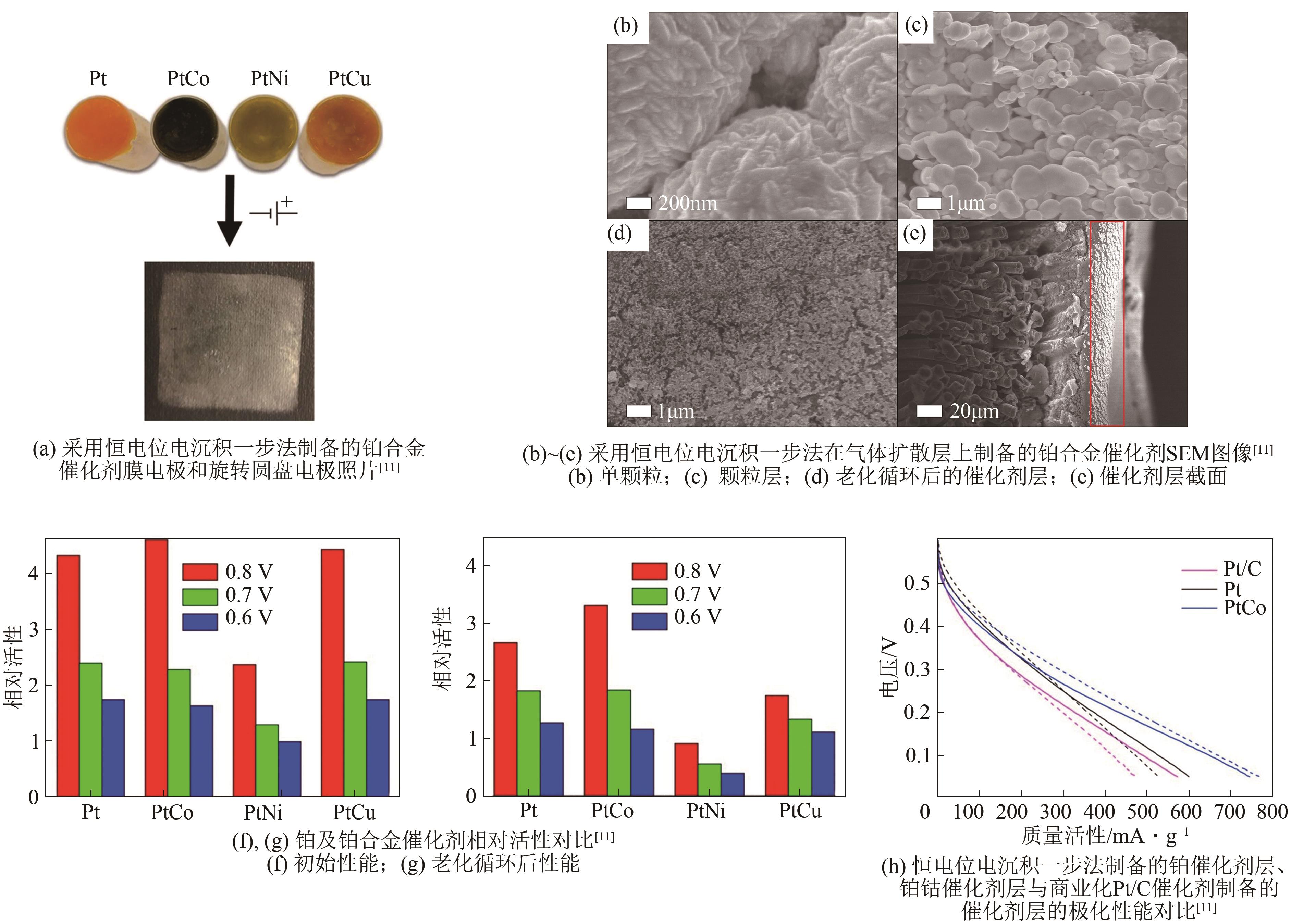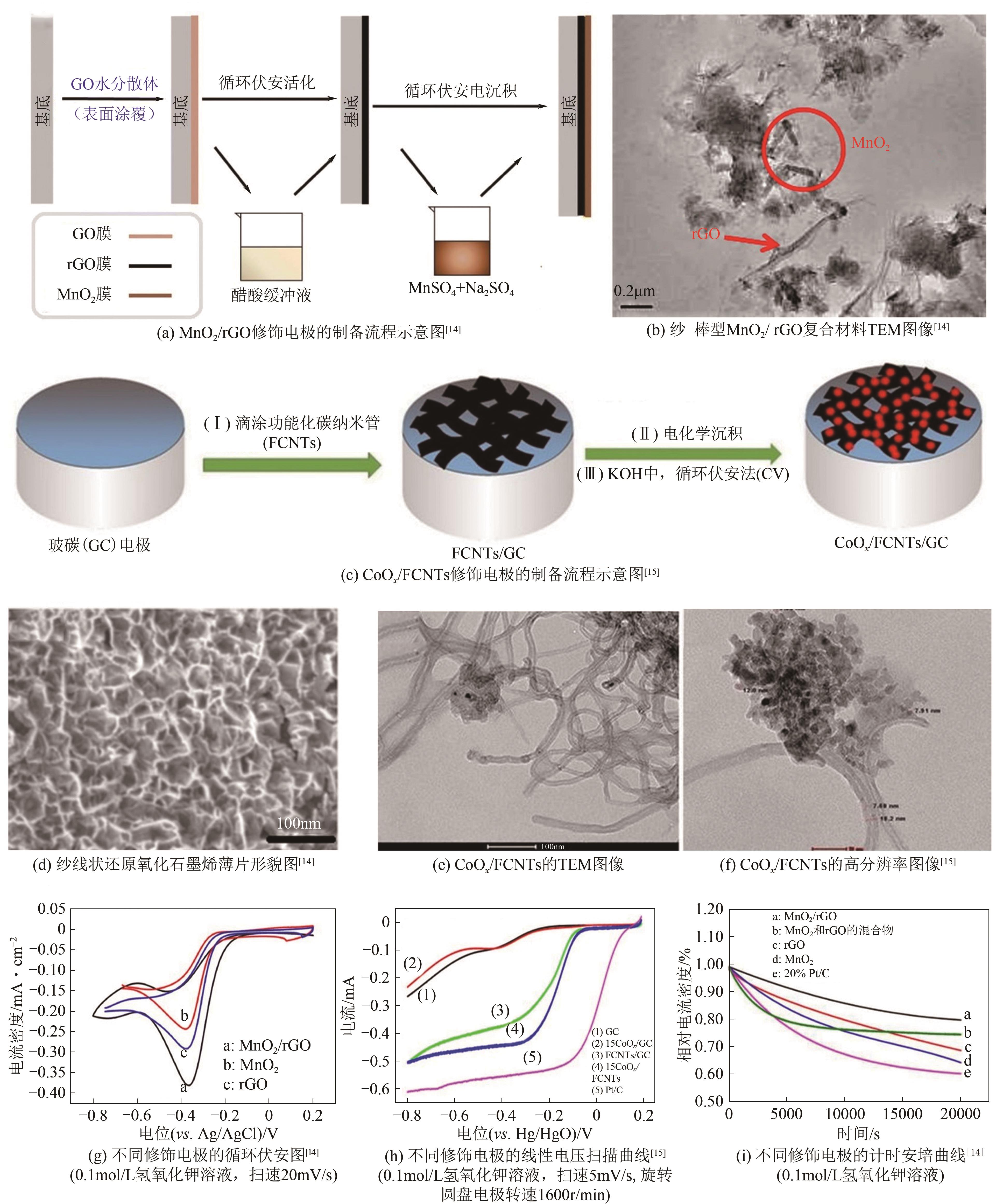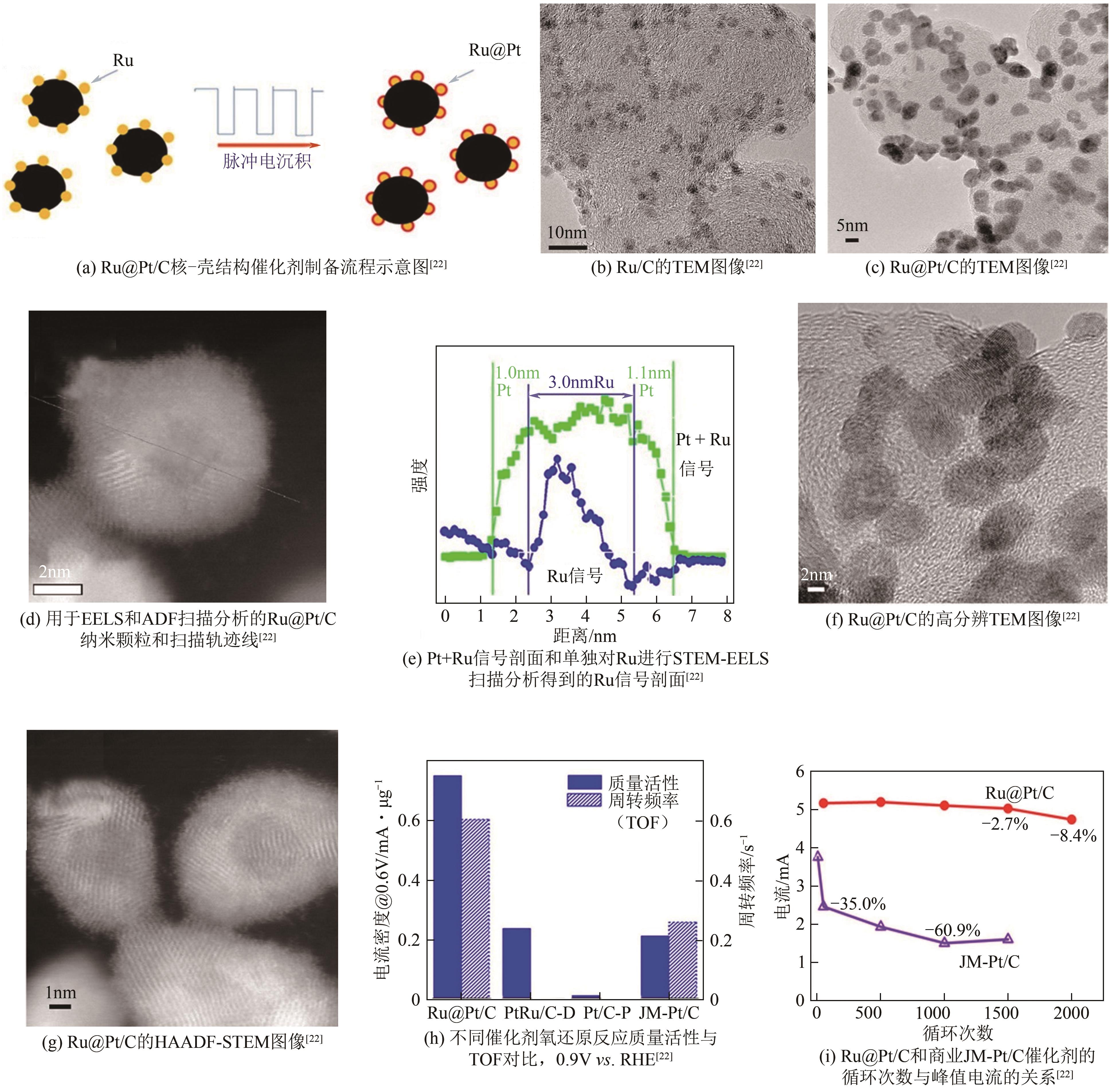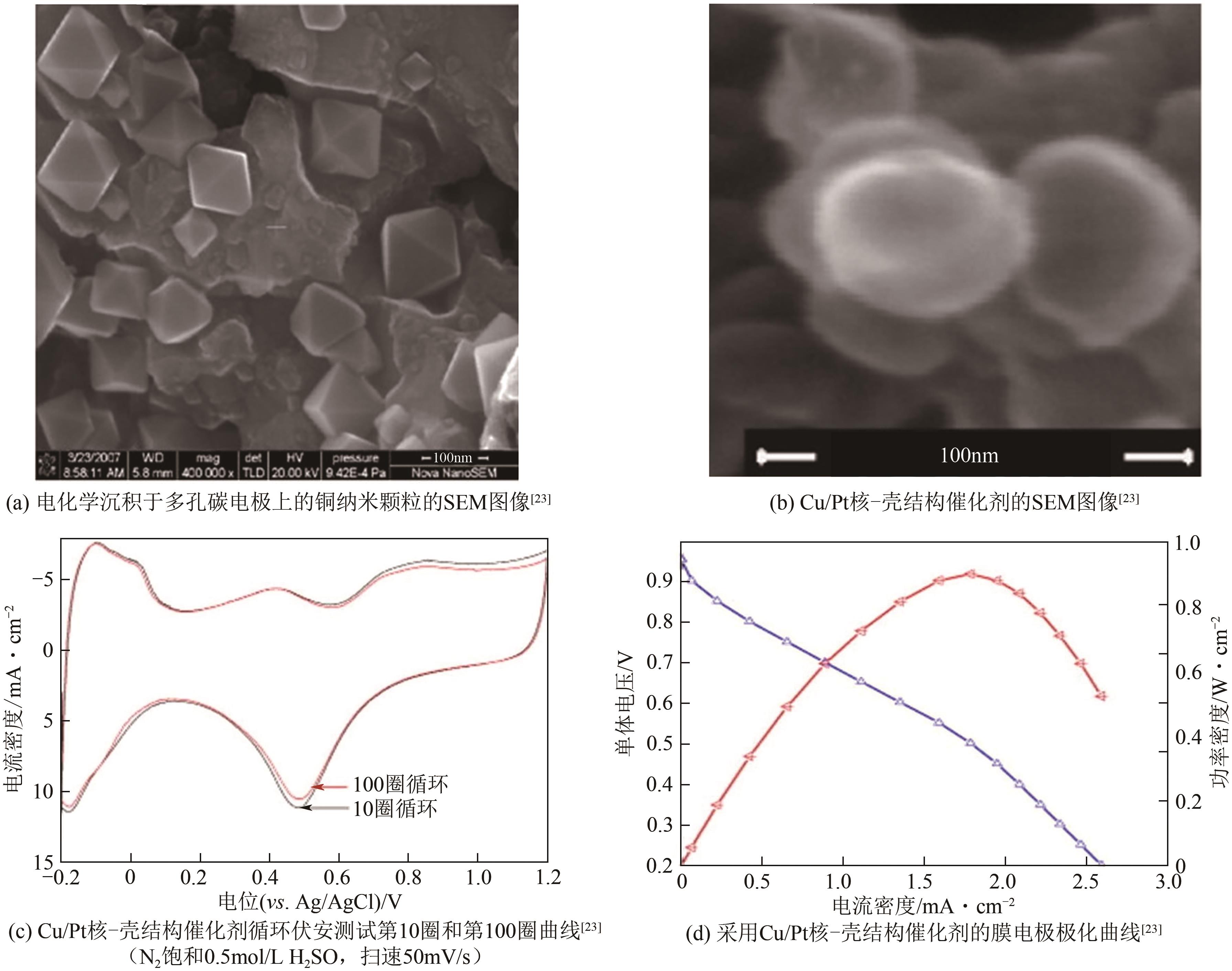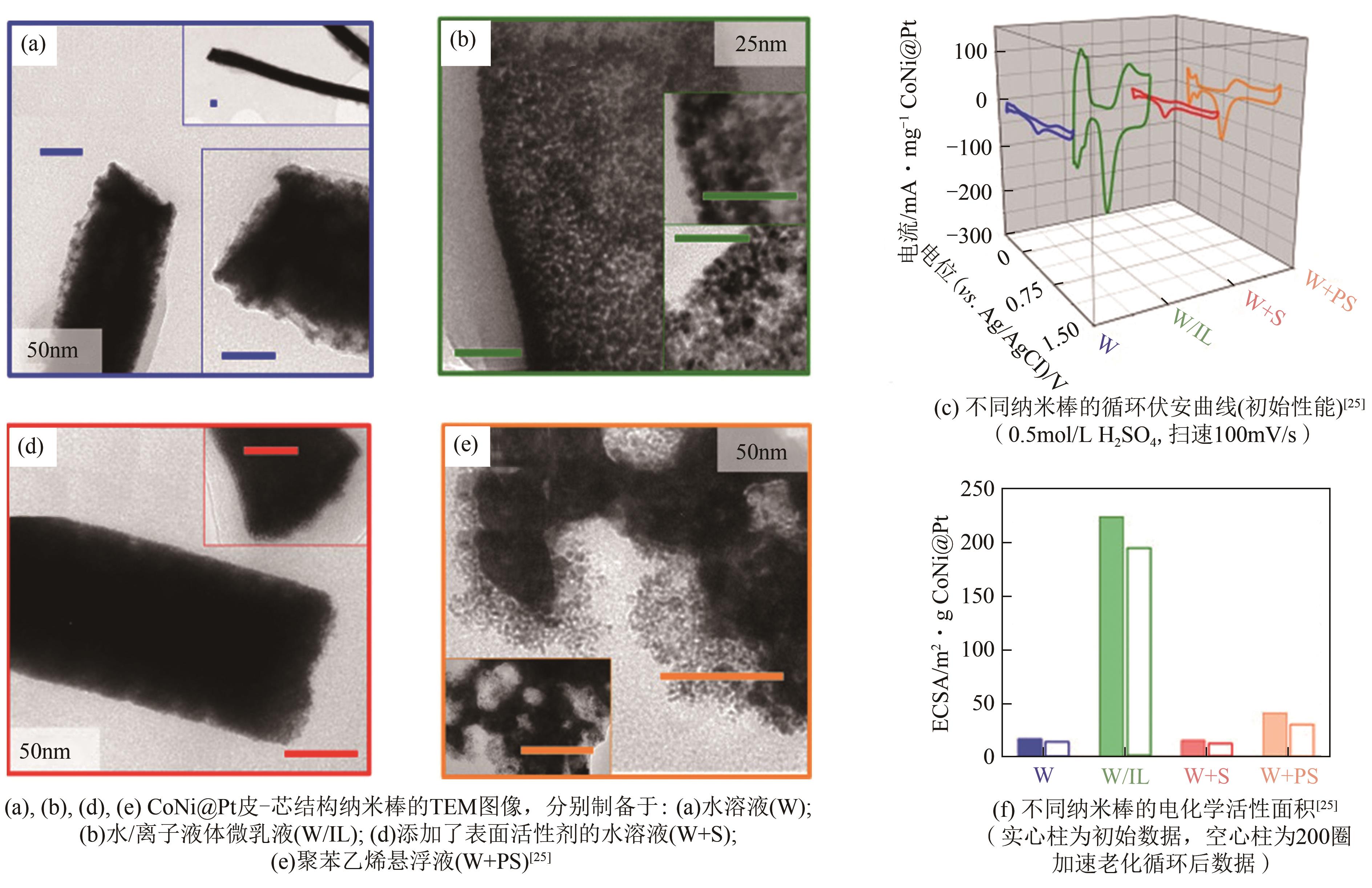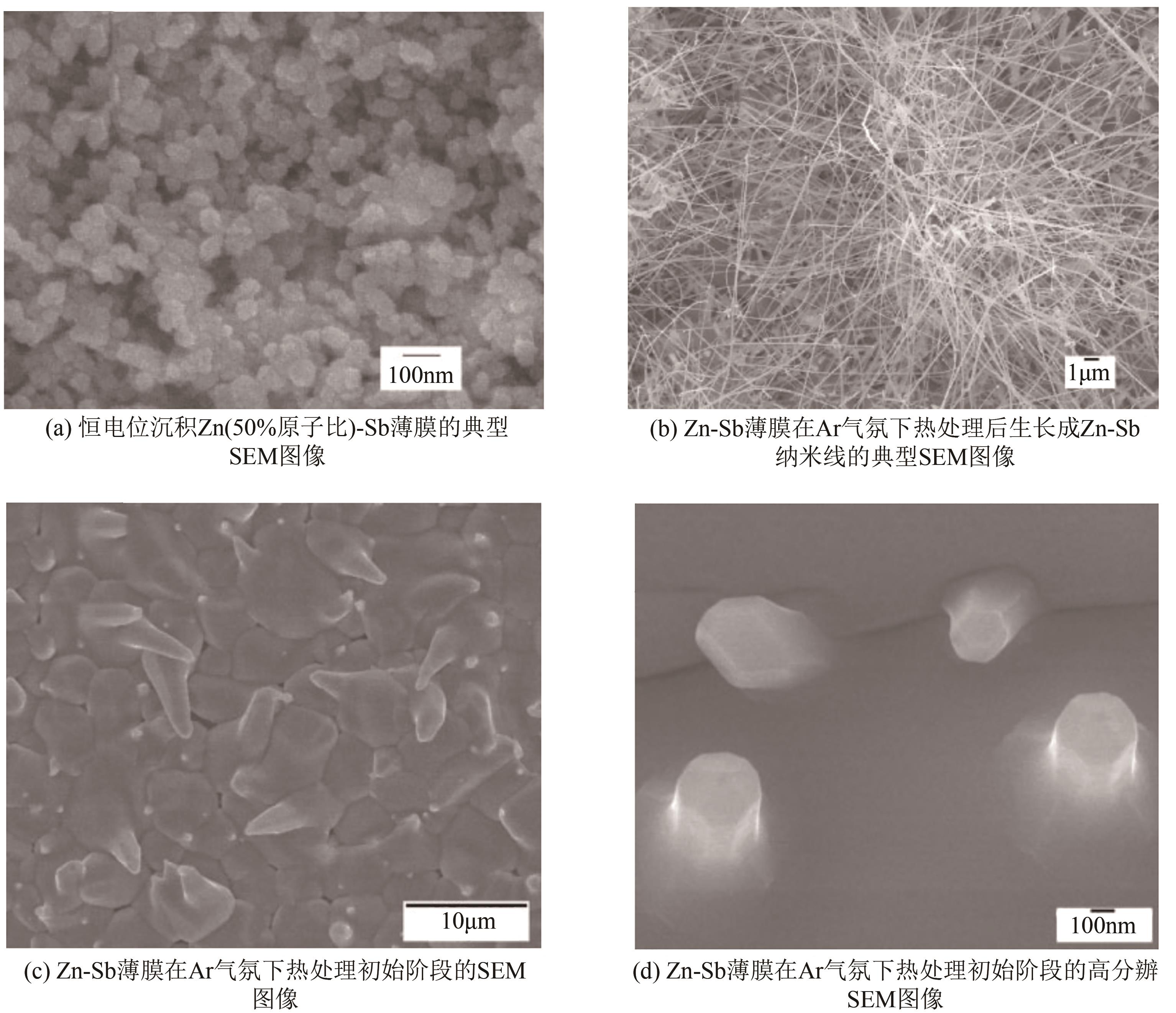Chemical Industry and Engineering Progress ›› 2024, Vol. 43 ›› Issue (4): 1796-1809.DOI: 10.16085/j.issn.1000-6613.2023-0695
• Industrial catalysis • Previous Articles
Preparation of PEMFC catalysts by electrodeposition
CHEN Jiayi1( ), GAO Weitao2, YIN Yanan2, WANG Cheng2, OUYANG Hongwu1(
), GAO Weitao2, YIN Yanan2, WANG Cheng2, OUYANG Hongwu1( ), MAO Zongqiang2
), MAO Zongqiang2
- 1.College of Mechanical and Electrical Engineering, Central South University, Changsha 410083, Hunan, China
2.Institute of Nuclear and New Energy Technology, Tsinghua University, Beijing 100084, China
-
Received:2023-04-27Revised:2023-10-07Online:2024-05-13Published:2024-04-15 -
Contact:OUYANG Hongwu
电化学沉积法制备质子交换膜燃料电池催化剂
陈家一1( ), 高帷韬2, 阴亚楠2, 王诚2, 欧阳鸿武1(
), 高帷韬2, 阴亚楠2, 王诚2, 欧阳鸿武1( ), 毛宗强2
), 毛宗强2
- 1.中南大学机电工程学院,湖南 长沙 410083
2.清华大学核能与新能源技术研究院,北京 100084
-
通讯作者:欧阳鸿武 -
作者简介:陈家一(2000—),男,硕士研究生,研究方向为氢燃料电池。E-mail:cjy_csu@csu.edu.cn。 -
基金资助:国家自然科学基金(52375138);湖南省重点领域研发计划(2023GK2044)
CLC Number:
Cite this article
CHEN Jiayi, GAO Weitao, YIN Yanan, WANG Cheng, OUYANG Hongwu, MAO Zongqiang. Preparation of PEMFC catalysts by electrodeposition[J]. Chemical Industry and Engineering Progress, 2024, 43(4): 1796-1809.
陈家一, 高帷韬, 阴亚楠, 王诚, 欧阳鸿武, 毛宗强. 电化学沉积法制备质子交换膜燃料电池催化剂[J]. 化工进展, 2024, 43(4): 1796-1809.
share this article
Add to citation manager EndNote|Ris|BibTeX
URL: https://hgjz.cip.com.cn/EN/10.16085/j.issn.1000-6613.2023-0695
| 1 | JIAO Kui, XUAN Jin, DU Qing, et al. Designing the next generation of proton-exchange membrane fuel cells[J]. Nature, 2021, 595(7867): 361-369. |
| 2 | DEBE Mark K. Electrocatalyst approaches and challenges for automotive fuel cells[J]. Nature, 2012, 486(7401): 43-51. |
| 3 | ZHANG Qingnuan, DONG Shuda, SHAO Pengpeng, et al. Covalent organic framework-based porous ionomers for high-performance fuel cells[J]. Science, 2022, 378(6616): 181-186. |
| 4 | 高帷韬, 雷一杰, 张勋, 等. 质子交换膜燃料电池研究进展[J]. 化工进展, 2022, 41(3): 1539-1555. |
| GAO Weitao, LEI Yijie, ZHANG Xun, et al. An overview of proton exchange membrane fuel cell[J]. Chemical Industry and Engineering Progress, 2022, 41(3): 1539-1555. | |
| 5 | KALE Manoj B, BORSE Rahul Anil, GOMAA ABDELKADER MOHAMED Aya, et al. Electrocatalysts by electrodeposition: Recent advances, synthesis methods, and applications in energy conversion[J]. Advanced Functional Materials, 2021, 31(25): 2101313. |
| 6 | LI Ruopeng, LI Yun, YANG Peixia, et al. Electrodeposition: Synthesis of advanced transition metal-based catalyst for hydrogen production via electrolysis of water[J]. Journal of Energy Chemistry, 2021, 57: 547-566. |
| 7 | 吴尔卡, 薄拯, 胡丹, 等. 脉冲电沉积法应用于铂/垂直取向石墨烯直接甲醇燃料电池催化剂[J]. 化工新型材料, 2015, 43(2): 200-202. |
| WU Erka, BO Zheng, HU Dan, et al. Pulse electrodeposition of Pt on vertical oriented graphene as catalysts for DMFCs[J]. New Chemical Materials, 2015, 43(2): 200-202. | |
| 8 | MIAO Ming, DUAN Haotian, LUO Jiayao, et al. Recent progress and prospect of electrodeposition-type catalysts in carbon dioxide reduction utilizations[J]. Materials Advances, 2022, 3(18): 6968-6987. |
| 9 | LIU Jie, ZHONG Cheng, DU Xintong, et al. Pulsed electrodeposition of Pt particles on indium tin oxide substrates and their electrocatalytic properties for methanol oxidation[J]. Electrochimica Acta, 2013, 100: 164-170. |
| 10 | 史国玉, 王宗花, 夏建飞, 等. 电化学合成PtCo/石墨烯复合催化剂及对甲醇的电催化氧化[J]. 化学学报, 2013, 71(2): 227-233. |
| SHI Guoyu, WANG Zonghua, XIA Jianfei, et al. Electrochemical deposition of graphene supported PtCo composite catalysts for electrocatalytic methanol oxidation[J]. Acta Chimica Sinica, 2013, 71(2): 227-233. | |
| 11 | SORSA Olli, ROMAR Henrik, LASSI Ulla, et al. Co-electrodeposited mesoporous PtM (M=Co, Ni, Cu) as an active catalyst for oxygen reduction reaction in a polymer electrolyte membrane fuel cell[J]. Electrochimica Acta, 2017, 230: 49-57. |
| 12 | HONG Shaojing, HOU Ming, ZHANG Hongjie, et al. A high-performance PEM fuel cell with ultralow platinum electrode via electrospinning and underpotential deposition[J]. Electrochimica Acta, 2017, 245: 403-409. |
| 13 | SAEJENG Yupa, TANTAVICHET Nisit. Preparation of Pt-Co alloy catalysts by electrodeposition for oxygen reduction in PEMFC[J]. Journal of Applied Electrochemistry, 2009, 39(1): 123-134. |
| 14 | HUANG Baohua, ZHANG Xiaofeng, CAI Jiannan, et al. A novel MnO2/rGO composite prepared by electrodeposition as a non-noble metal electrocatalyst for ORR[J]. Journal of Applied Electrochemistry, 2019, 49(8): 767-777. |
| 15 | AL-HAKEMY Ahmed Zaki, NASSR Abu Bakr Ahmed Amine, NAGGAR Ahmed Hosny, et al. Electrodeposited cobalt oxide nanoparticles modified carbon nanotubes as a non-precious catalyst electrode for oxygen reduction reaction[J]. Journal of Applied Electrochemistry, 2017, 47(2): 183-195. |
| 16 | WEI Z D, CHAN S H, LI L L, et al. Electrodepositing Pt on a Nafion-bonded carbon electrode as a catalyzed electrode for oxygen reduction reaction[J]. Electrochimica Acta, 2005, 50(11): 2279-2287. |
| 17 | MIYAKE Masao, UEDA Takeshi, HIRATO Tetsuji. Potentiostatic electrodeposition of Pt nanoparticles on carbon black[J]. Journal of the Electrochemical Society, 2011, 158(9): D590. |
| 18 | DUARTE M M E, PILLA A S, SIEBEN J M, et al. Platinum particles electrodeposition on carbon substrates[J]. Electrochemistry Communications, 2006, 8(1): 159-164. |
| 19 | KIM Hansung, SUBRAMANIAN Nalini P, POPOV Branko N. Preparation of PEM fuel cell electrodes using pulse electrodeposition[J]. Journal of Power Sources, 2004, 138(1/2): 14-24. |
| 20 | CHEN Siguo, WEI Zidong, LI Hua, et al. High Pt utilization PEMFC electrode obtained by alternative ion-exchange/electrodeposition[J]. Chemical Communications, 2010, 46: 8782-8784. |
| 21 | ZHAO Yue, FAN Louzhen, REN Jingling, et al. Electrodeposition of Pt-Ru and Pt-Ru-Ni nanoclusters on multi-walled carbon nanotubes for direct methanol fuel cell[J]. International Journal of Hydrogen Energy, 2014, 39(9): 4544-4557. |
| 22 | CHEN Dan, LI Yuexia, LIAO Shijun, et al. Ultra-high-performance core-shell structured Ru@Pt/C catalyst prepared by a facile pulse electrochemical deposition method[J]. Scientific Reports, 2015, 5: 11604. |
| 23 | WEI Z D, FENG Y C, LI L, et al. Electrochemically synthesized Cu/Pt core-shell catalysts on a porous carbon electrode for polymer electrolyte membrane fuel cells[J]. Journal of Power Sources, 2008, 180(1): 84-91. |
| 24 | LIU F, LEE J Y, ZHOU W J. Multisegment PtRu nanorods: Electrocatalysts with adjustable bimetallic pair sites[J]. Advanced Functional Materials, 2005, 15(9): 1459-1464. |
| 25 | SERRÀ A, GÓMEZ E, VALLÉS E. Novel electrodeposition media to synthesize CoNi-Pt Core@Shell stable mesoporous nanorods with very high active surface for methanol electro-oxidation[J]. Electrochimica Acta, 2015, 174: 630-639. |
| 26 | LIU P, GUO X, HUANG H, et al. The growth of Zn-Sb nanowires by heat treatment of Zn-Sb nanoparticles obtained by electrodeposition[J]. Advanced Materials, 2006, 18(14): 1873-1876. |
| 27 | WANG Hong, XU Changwei, CHENG Faliang, et al. Pd/Pt core-shell nanowire arrays as highly effective electrocatalysts for methanol electrooxidation in direct methanol fuel cells[J]. Electrochemistry Communications, 2008, 10(10): 1575-1578. |
| 28 | ZHANG Lili, WEI Meng, WANG Suqing, et al. Highly stable PtP alloy nanotube arrays as a catalyst for the oxygen reduction reaction in acidic medium[J]. Chemical Science, 2015, 6(5): 3211-3216. |
| 29 | LIU Bin, QU Shengxiang, KOU Yue, et al. In situ electrodeposition of cobalt sulfide nanosheet arrays on carbon cloth as a highly efficient bifunctional electrocatalyst for oxygen evolution and reduction reactions[J]. ACS Applied Materials & Interfaces, 2018, 10(36): 30433-30440. |
| [1] | LIU Ruolu, TANG Haibo, HE Feifei, LUO Fengying, WANG Jinge, YANG Na, LI Hongwei, ZHANG Ruiming. Recent research and prospect of liquid organic hydrogen carries technology [J]. Chemical Industry and Engineering Progress, 2024, 43(4): 1731-1741. |
| [2] | QIAN Zhiguang, WANG Shixue, ZHU Yu, YUE Like. Start-up characteristics of high-temperature proton exchange membrane fuel cell stacks based on flat heat pipes [J]. Chemical Industry and Engineering Progress, 2024, 43(4): 1754-1763. |
| [3] | WANG Hongyan, MA Ziran, LI Ge, MA Jing, ZHAO Chunlin, ZHOU Jiali, WANG Lei, PENG Shengpan. Research progress in synergistic catalytic elimination of multiple pollutants in flue gas of coal combustion coupled with renewable fuels [J]. Chemical Industry and Engineering Progress, 2024, 43(4): 1783-1795. |
| [4] | LIU Fangwang, HAN Yi, ZHANG Jiajia, BU Honghong, WANG Xingpeng, YU Chuanfeng, LIU Mengshuai. Research advance of heterogeneous catalytic system for the coupling between CO2 and epoxide into propylene carbonate [J]. Chemical Industry and Engineering Progress, 2024, 43(3): 1252-1265. |
| [5] |
ZHANG Pengfei, YAN Zhangyan, REN Liang, ZHAGN Kui, LIANG Jialin, ZHAO Guangle, ZHANG Fanbin, HU Zhihai.
Research progress in the catalytic hydrodealkylation of C |
| [6] | GU Xingpeng, MA Hongqin, LIU Jiahao. Modification of Rainey nickel with phosphorus quantum dots and its catalytic hydrodesulfurization performances [J]. Chemical Industry and Engineering Progress, 2024, 43(3): 1293-1301. |
| [7] | ZHANG Shuming, LIU Huazhang. Optimization of Fe1-x O ammonia synthesis catalyst by BP neural network model [J]. Chemical Industry and Engineering Progress, 2024, 43(3): 1302-1308. |
| [8] | LI Kairui, GAO Zhaohua, LIU Tiantian, LI Jing, WEI Haisheng. Tuning the catalytic performance of Rh/FePO4 catalyst by reduction temperature for quinoline selective hydrogenation [J]. Chemical Industry and Engineering Progress, 2024, 43(3): 1342-1349. |
| [9] | LIU Bin, WANG Yongjun, LYU Wangyang, CHEN Wenxing. Preparation and application of high stability titanium polyester catalyst TiOC@SiO2 [J]. Chemical Industry and Engineering Progress, 2024, 43(3): 1395-1402. |
| [10] | WANG Xiong, KANG Wenqian, REN Yue, QIAO Tongsen, ZHANG Peng, HUANG Anping, LI Guangquan. Pilot scale production of porous organic polymers and their application in polyolefin catalysts [J]. Chemical Industry and Engineering Progress, 2024, 43(3): 1412-1417. |
| [11] | YAN Shoucheng, ZHANG Huihua, XU Qianqian, WANG Yukun. Application of graphene composite supported catalyst in the removal of NO from diesel exhaust [J]. Chemical Industry and Engineering Progress, 2024, 43(3): 1456-1465. |
| [12] | DONG Bingyan, LI Zhendong, WANG Peixiang, TU Wenjuan, TAN Yanwen, ZHANG Qin. Performance and mechanism of the degradation of benzohydroxamic acid by DBD plasma-coupled BiOI catalytic materials [J]. Chemical Industry and Engineering Progress, 2024, 43(3): 1565-1575. |
| [13] | CHEN Xiaozhen, LIU Li, YANG Chengmin, ZHENG Bumei, YIN Xiaoying, SUN Jin, YAO Yunhai, DUAN Weiyu. Research progress of alumina-supported hydrodesulfurization catalyst [J]. Chemical Industry and Engineering Progress, 2024, 43(2): 948-961. |
| [14] | DING Kang, HE Junqiao, CHEN Yuanjie, YANG Xiazhen, LIU Huazhang, HUO Chao. Effect of hydrochloric acid treatment on catalytic performance of Ru/Ba-MgO catalyst template cotton fiber [J]. Chemical Industry and Engineering Progress, 2024, 43(2): 962-970. |
| [15] | WANG Darui, SUN Hongmin, WANG Yiyan, TANG Zhimou, LI Rui, FAN Xueyan, YANG Weimin. Recent progress in zeolite for efficient catalytic reaction process [J]. Chemical Industry and Engineering Progress, 2024, 43(1): 1-18. |
| Viewed | ||||||
|
Full text |
|
|||||
|
Abstract |
|
|||||
